Beyond words: A conversation with Lindsay Butler, PhD, CCC-SLP
Interview and story by Ava Buckmir
Dr. Lindsay Butler is among the newest faculty members in the Speech, Language, and Hearing Sciences (SLHS) department at the University of Connecticut. She has a PhD in linguistics from Penn State, is a certified speech-language pathologist, and completed a postdoctoral fellowship at Boston University. Her work revolves around learning about how nonverbal and minimally verbal children on the autism spectrum understand language.
[Buckmir] As a double major in SLHS and psychology, I have learned quite a bit about autism and its impacts on speech and language, but I was eager to learn more about Butler’s work with nonverbal and minimally verbal youth. I began our conversation by asking her what sparked her interest in working with this specific population, especially as it is one that can be hard to work with:
“One of the reasons I do the research that I do with kids on the autism spectrum who are nonverbal or have minimal spoken language is because working with them as a clinician was really, really hard, just because there’s not much research on them, so there’s no evidence-base for ‘how do we help them develop more complex language’ and ‘how do we help them communicate better.'”

[Buckmir] Butler mentioned that 1 in 4 children diagnosed with autism are nonverbal or minimally verbal. Despite this dramatic statistic, minimal research exists on how these people experience language. Butler’s lab, the Brain & Language on the Autism Spectrum Lab, aims to measure what language these nonverbal and minimally verbal individuals understand to better recognize autism spectrum disorder itself. I asked her what her lab does and why autism is important for people to understand:
“There’s been a little bit of research on receptive language [listening and reading] suggesting that of those individuals who are nonverbal, at least 25% of them have good receptive language. But we don’t have good ways to test that. You can’t really do a paper and pencil assessment with them because of behavioral challenges, attention issues, and having a severe communication impairment — it’s hard to communicate.
We’re starting to look at receptive language and we have designed a study to really meet the needs of nonverbal kids. We’re doing it remotely so they can do it at home with a parent so they’re comfortable. There’s research that shows they [minimally verbal and nonverbal children] perform better in those circumstances than if we try to bring them into the lab or the clinic where it’s an unfamiliar environment with a new person. They can give a touch screen response; it’s a pictureword matching task so they hear a word, see four pictures, and they can give a touch screen response, so it has very low communication demands.
I think people just assume that they’re severely cognitively-impaired because we don’t have a way to test what they know. So making something that meets their unique needs, we have a way to test that and they understand way more than everyone assumes they can. And I hope that message gets out there too because I think, this might happen with people who have aphasia also, especially if it’s more severe, people will talk about them, in their presence, kind of thinking that they don’t understand and it’s hurtful to those people. They probably understand more than what people think they understand, which is absolutely the case with nonverbal people on the autism spectrum.”

[Buckmir] Butler’s lab also uses brain imaging techniques, primarily focusing on functional near-infrared spectroscopy (fNIRS), which allows researchers to pass light into the top surface of the brain to see which parts are working or not. As someone who has used other brain imaging techniques (primarily measuring the electrical output of the brain using electroencephalography, or EEG) I wanted to know more about fNIRS and how she implements it in her work with the autism population:
“In my lab, we’re using a new brain imaging technique called near-infrared spectroscopy that is much more ‘autism friendly.’ It’s wearable and portable, so it’s a bit more sensory friendly. So it’s a cap and then the instrument is actually quite small so you can wear it on your back like a backpack. It’s the kind of thing that we can even take to someone’s home and do brain imaging there where they’re going to be more comfortable.”
[Buckmir] I was fascinated to learn about Dr. Butler’s work with nonverbal and minimally verbal youth on the autism spectrum. Her lab provides accessible testing that includes adaptations that fit the needs of these youth, such as the use of fNIRS and comfortable environmental options. Understanding the true nature of language acquisition in the autism population is critical in fully grasping the inner workings of this understudied disorder and I hope that future research can expand upon this work to provide more interventions and treatments for this population that can be hard to work with. I thanked Butler for her time, thought-provoking answers, and commitment to being a part of this interview.
Find more information on Butler’s research at her website: https://butlerlab.speech-language-hearing.uconn.edu/





